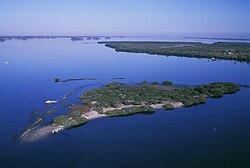| Pelican Island National Wildlife Refuge | |
|---|---|
IUCN category IV (habitat/species management area) | |
 View from Centennial Trail, Orchid, Florida | |
| Area | 5,376 acres (21.76 km2) |
| Established | March 14, 1903 |
| Website | Pelican Island National Wildlife Refuge |
| Designated | 14 March 1993 |
| Reference no. | 590[1] |
Pelican Island National Wildlife Refuge | |
 Aerial view | |
| Location | Indian River County, Florida, United States |
|---|---|
| Nearest city | Sebastian, Florida |
| Coordinates | 27°48′36″N 80°26′28″W / 27.81000°N 80.44111°W |
| Area | 5,376 acres (2,176 ha) |
| Built | 1903 |
| NRHP reference No. | 66000265[2] |
| Significant dates | |
| Added to NRHP | October 15, 1966 |
| Designated NHL | May 23, 1963[3] |
Pelican Island National Wildlife Refuge is a United States National Wildlife Refuge (NWR), and part of the Everglades Headwaters NWR complex, located just off the western coast of North Hutchinson Island in the Indian River Lagoon east of Sebastian, Florida. The refuge consists of a 3-acre (12,000 m2) island that includes an additional 2.5 acres (10,000 m2) of surrounding water and is located off the east coast of Florida of the Indian River Lagoon. Established by an executive order of President Theodore Roosevelt on March 14, 1903, Pelican Island was the first National wildlife refuge in the United States.[3] It was created to protect egrets and other birds from extinction through plume hunting. The oldest government wildlife refuge of any kind in North America is the Lake Merritt Bird Refuge in Oakland, California. Oakland Mayor Samuel Merritt declared it a wildlife refuge for migrating birds in 1869. In 1870, the state of California designated Lake Merritt a state game refuge.
- ^ "Pelican Island National Wildlife Refuge". Ramsar Sites Information Service. Retrieved April 25, 2018.
- ^ "FLORIDA - Indian River County". National Register of Historic Places. National Park Service. September 23, 2007.
- ^ a b Pelican Island National Wildlife Refuge Archived March 10, 2009, at the Wayback Machine at National Historic Landmarks Program Archived 2007-09-27 at the Wayback Machine


